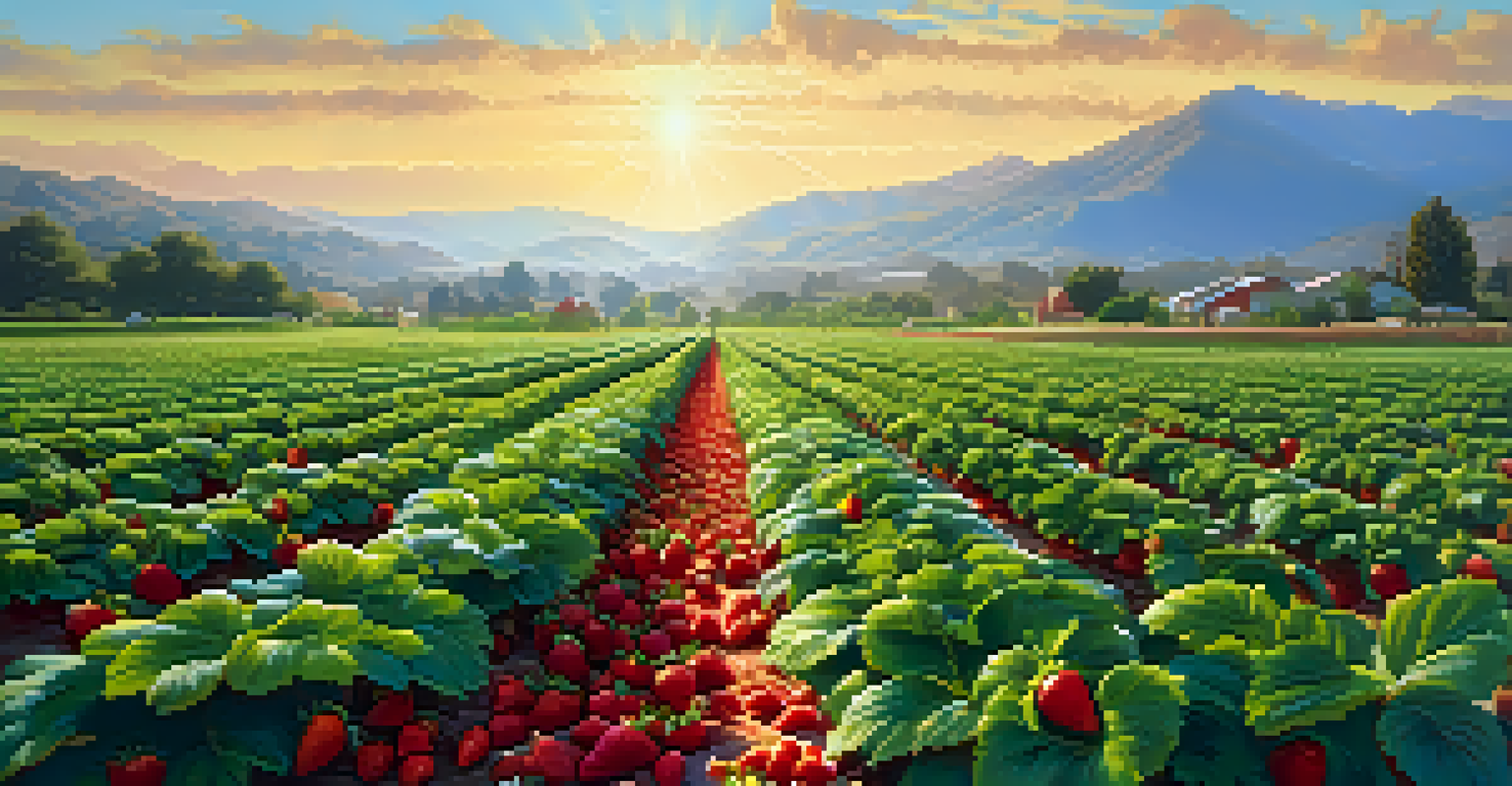California's Top Crops: A Deep Dive into Agricultural Output

Introduction: The Agricultural Heart of California
California is often referred to as the agricultural heart of the United States, producing a significant portion of the nation's fruits, vegetables, and nuts. With its diverse climates and rich soils, it’s no wonder that the state leads in agricultural output. From the Central Valley to coastal regions, California's farms contribute immensely to both local and global markets.
Agriculture is our wisest pursuit, because it will in the end contribute most to real wealth, good morals, and happiness.
The state's agricultural sector is not just a powerhouse; it’s a vital part of its cultural identity. Many communities thrive on farming traditions that have been passed down through generations. This deep-rooted connection to agriculture shapes the economy and lifestyle of countless Californians.
In this article, we’ll delve into the top crops that define California’s agricultural landscape. We'll explore the economic impact of these crops, the farming practices involved, and what makes this state a unique agricultural haven.
Almonds: California's Nutty Goldmine
Almonds have become synonymous with California’s agricultural success, with the state producing over 80% of the world’s supply. These nutrient-packed nuts thrive in California's warm climate, making them a lucrative crop for farmers. The almond industry not only generates billions in revenue but also supports thousands of jobs in farming, processing, and distribution.

Interestingly, almond farming is also a significant contributor to environmental discussions. While they require substantial water, many farmers are adopting sustainable practices to balance water use with production. Innovations like drip irrigation are making it possible to grow almonds more efficiently while minimizing environmental impact.
California: Agricultural Powerhouse
California leads the nation in agricultural output, producing a significant portion of the country's fruits, vegetables, and nuts.
As consumer demand for healthy snacks continues to rise, the future of almond farming looks promising. With global markets expanding and more people recognizing the health benefits of almonds, California’s farmers are likely to see continued success in this nutty goldmine.
Grapes: The Backbone of California's Wine Industry
Grapes are not just a staple fruit in California; they are the cornerstone of the state’s prestigious wine industry. With diverse grape varieties cultivated across regions like Napa Valley and Sonoma, California produces around 90% of the wine in the U.S. This thriving industry contributes billions to the economy and attracts millions of tourists annually.
The farmer has to be an optimist or he wouldn’t still be a farmer.
The growing conditions in California—ample sunshine, rich soil, and varying climates—create perfect conditions for grape cultivation. Winemakers are constantly experimenting with different techniques to enhance flavor profiles and improve sustainability. This innovation keeps California at the forefront of the global wine market.
Moreover, the cultural significance of wine in California cannot be understated. Wine tasting tours and festivals are popular activities, showcasing the deep-rooted traditions of viticulture in the state. Grapes truly encapsulate California's identity as a leader in both agriculture and tourism.
Strawberries: A Sweet California Delight
California strawberries are renowned for their sweetness and quality, making the state the largest producer in the U.S. With an ideal climate and rich soil, California’s strawberry farms yield millions of pounds each year. The strawberry season typically runs from March to November, during which farmers work tirelessly to meet consumer demand.
The economic impact of strawberries extends beyond just their production. They support local economies, contribute to farm-to-table initiatives, and even create opportunities for agritourism. Visitors flock to pick-your-own farms, making strawberry picking a cherished family activity in the state.
Sustainable Farming Practices Rising
Many California farmers are adopting sustainable practices to balance crop production with environmental responsibility.
Sustainability is also a key focus for strawberry farmers, who are implementing eco-friendly practices to reduce pesticide use and conserve water. This commitment to sustainable agriculture ensures that California strawberries will remain a beloved staple for years to come.
Lettuce: The Leafy Green Leader
When it comes to lettuce, California stands out as the leading producer in the United States. The state’s cool coastal climate provides the perfect growing conditions for various lettuce types, such as romaine and butterhead. These greens are essential for salads and sandwiches, making them a dietary staple across the nation.
Lettuce farming is a significant economic driver within California's agricultural sector. With thousands of acres dedicated to this leafy green, farmers employ advanced techniques to ensure high yield and quality. From planting to harvesting, the process is labor-intensive and requires precise management.
Interestingly, lettuce farming also faces challenges, particularly related to water use and pest management. Farmers are increasingly adopting sustainable practices, including crop rotation and organic farming, to address these issues. This commitment to sustainability is helping to secure the future of lettuce production in California.
Tomatoes: A Versatile Crop with Global Appeal
California is a leading producer of tomatoes, particularly processing tomatoes used in sauces, soups, and canned products. The state’s warm climate and fertile soil make it an ideal location for cultivating this versatile crop. Tomato farming not only fulfills national demand but also caters to international markets.
The economic significance of tomatoes in California is substantial, with billions generated each year. This crop supports a vast network of farmers, processors, and distributors. Additionally, the state’s annual tomato harvest showcases the hard work and dedication of its agricultural community.
Diverse Crops Drive Local Economy
Crops like almonds, grapes, and strawberries not only contribute to California's economy but also shape its cultural identity.
As consumers become more health-conscious, the demand for fresh and organic tomatoes is on the rise. Farmers are responding by diversifying their offerings and embracing sustainable farming methods. This shift not only benefits the environment but also meets the evolving preferences of consumers.
Rice: The Unsung Hero of California's Agriculture
Rice might not be the first crop that comes to mind when thinking of California agriculture, but it plays a vital role in the state’s economy. California is the second-largest rice producer in the U.S., primarily cultivating medium-grain varieties. The Sacramento Valley is known for its rich rice paddies, which contribute significantly to the state's agricultural output.
Rice farming is a complex process that involves careful water management and crop rotation to ensure sustainability. California rice farmers are adopting innovative practices to minimize water use while maximizing yields. This commitment to sustainability is essential for both the environment and the farmers' livelihoods.

Moreover, California rice has gained recognition for its quality, with many brands establishing a strong presence in the market. As global demand for rice continues to grow, California's farmers are poised to play an essential role in meeting this need while maintaining environmentally friendly practices.
Conclusion: California's Agricultural Future
As we’ve explored, California’s agricultural output is diverse and vital to both the state and the nation. From almonds to rice, each crop contributes uniquely to the economy and showcases the hard work of farmers across the state. The commitment to sustainability and innovation is a testament to the resilience of California’s agricultural community.
Looking ahead, the challenges posed by climate change and water scarcity will require continued adaptation and collaboration among farmers, researchers, and policymakers. By focusing on sustainable practices and embracing technology, California's agriculture can continue to thrive in an ever-changing environment.
Ultimately, California's agricultural landscape tells a story of tradition, innovation, and community. As we celebrate the state’s top crops, we also look forward to a future where agriculture remains a cornerstone of California's identity and economy.